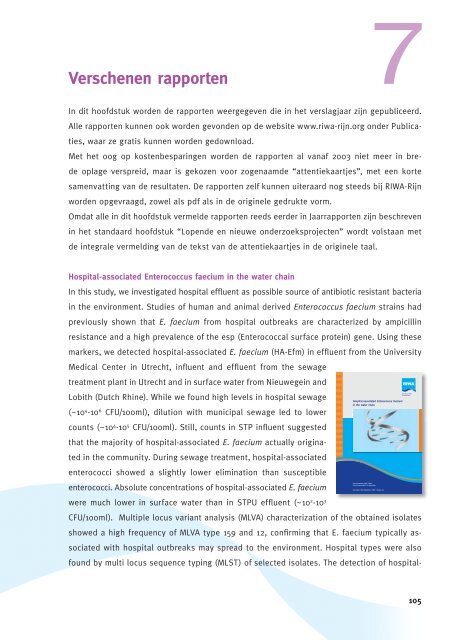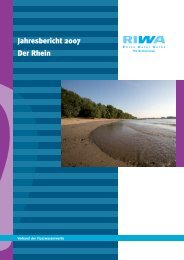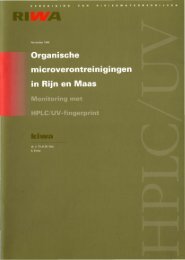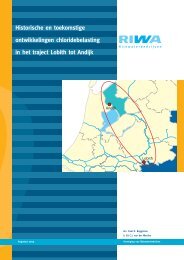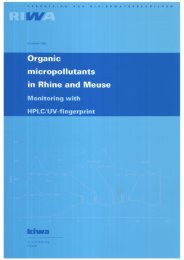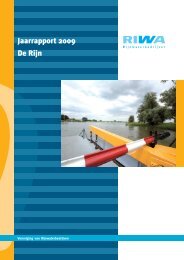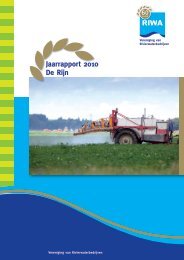Jaarrapport 2011 De Rijn - Riwa
Jaarrapport 2011 De Rijn - Riwa
Jaarrapport 2011 De Rijn - Riwa
You also want an ePaper? Increase the reach of your titles
YUMPU automatically turns print PDFs into web optimized ePapers that Google loves.
Verschenen rapporten<br />
7<br />
In dit hoofdstuk worden de rapporten weergegeven die in het verslagjaar zijn gepubliceerd.<br />
Alle rapporten kunnen ook worden gevonden op de website www.riwa-rijn.org onder Publicaties,<br />
waar ze gratis kunnen worden gedownload.<br />
Met het oog op kostenbesparingen worden de rapporten al vanaf 2003 niet meer in brede<br />
oplage verspreid, maar is gekozen voor zogenaamde “attentiekaartjes”, met een korte<br />
samenvatting van de resultaten. <strong>De</strong> rapporten zelf kunnen uiteraard nog steeds bij RIWA-<strong>Rijn</strong><br />
worden opgevraagd, zowel als pdf als in de originele gedrukte vorm.<br />
Omdat alle in dit hoofdstuk vermelde rapporten reeds eerder in <strong>Jaarrapport</strong>en zijn beschreven<br />
in het standaard hoofdstuk “Lopende en nieuwe onderzoeksprojecten” wordt volstaan met<br />
de integrale vermelding van de tekst van de attentiekaartjes in de originele taal.<br />
Hospital-associated Enterococcus faecium in the water chain<br />
In this study, we investigated hospital effl uent as possible source of antibiotic resistant bacteria<br />
in the environment. Studies of human and animal derived Enterococcus faecium strains had<br />
previously shown that E. faecium from hospital outbreaks are characterized by ampicillin<br />
resistance and a high prevalence of the esp (Enterococcal surface protein) gene. Using these<br />
markers, we detected hospital-associated E. faecium (HA-Efm) in effl uent from the University<br />
Medical Center in Utrecht, infl uent and effl uent from the sewage<br />
treatment plant in Utrecht and in surface water from Nieuwegein and<br />
Rhine Water Works<br />
The Netherlands<br />
Lobith (Dutch Rhine). While we found high levels in hospital sewage<br />
Hospital-associated Enterococcus faecium<br />
in the water chain<br />
(~10<br />
Iacovos Anastasiou, Heike Schmitt<br />
Utrecht University/IRAS, The Netherlands<br />
Association of River Waterworks - RIWA • Februari <strong>2011</strong>.<br />
4-106 CFU/100ml), dilution with municipal sewage led to lower<br />
counts (~104-105 CFU/100ml). Still, counts in STP infl uent suggested<br />
that the majority of hospital-associated E. faecium actually originated<br />
in the community. During sewage treatment, hospital-associated<br />
enterococci showed a slightly lower elimination than susceptible<br />
enterococci. Absolute concentrations of hospital-associated E. faecium<br />
were much lower in surface water than in STPU effl uent (~102-103 CFU/100ml). Multiple locus variant analysis (MLVA) characterization of the obtained isolates<br />
showed a high frequency of MLVA type 159 and 12, confi rming that E. faecium typically associated<br />
with hospital outbreaks may spread to the environment. Hospital types were also<br />
found by multi locus sequence typing (MLST) of selected isolates. The detection of hospital-<br />
105


